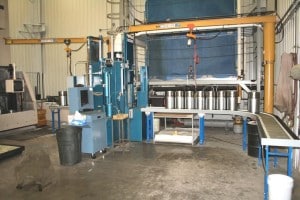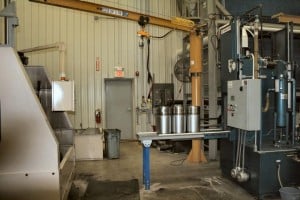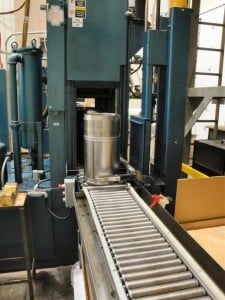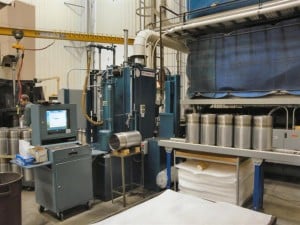1.) What kind of washer is this?
This is a custom built pass-through parts washer that will spray wash engine liners including their center nozzles, shop air blow off and dip each part into a tank to coat them with a dry-touch oil after the cleaning/blow-off cycle. The cleaned product is spot-free. The system was designed so that every fourth piece was not automatically dipped, so it could be inspected first, then dipped.
2.) What was this machine engineered to clean?
The washer was designed to clean canister engine liners which had to be debris free and chemical free. Previously the customer had been using a cabinet washer in which several liners were placed on the table surface of the washer. A spray bar would spin during the cleaning process, while the table remained stationary. This was not getting the parts clean to specifications, due to parts shadowing of parts and no filtration on the washer.
This client wanted an inline cell process in which the cleaning would occur immediately after the honing process, and, following cleaning, the engine liner would be coated in a dry touch oil or be inspected then oil coated.
3.) How did you solve the client’s cleaning problem?
AEC Systems designed a pass-through washer to meet the customer’s unique cleaning needs. The finished washer was automatically fed and had a wash chamber with an oscillating center nozzle and an outer halo that moved up and down inside the liner as it was being washed, followed by a cycle of rinse and shop air blow off directed toward rings in the bottom of the liner. After cleaning, each part advanced to a dip tank where the part was dipped in oil and then brought back up to drip until the 2.5 minute cleaning/blow-off cycle was complete. A baghouse filter removed fine debris from the wash solution for an extended bath life, and this washer had an oil coalescer that removed free floating oils while the washer was running. We sized the project within the 10-foot space footprint that the customer had available to use.
4.) What were the specific challenges for this project? What did you learn from doing this project?
The rings at the bottom of each liner required more drying than the customer initially thought. Additional nozzles and drying time were added to accomplish this. For similar projects we would factor these drying/heating needs into an early design. The more specific information we have about a customer’s cleaning needs, the more effective and efficient washer we can create for them. This project started with the client’s inquiry into inline washers and ended with the manufacture of a compact, automatically fed washer that also included a final touch-dry coating stage before parts were packed and ready to ship.
5.) What else could this type of industrial parts washer be used/modified for?
Each AEC Systems project is designed to address unique cleaning needs, but this washer could be modified to include a soaking stage if the parts to be cleaned had any baked on or harder to remove contaminants. Additionally a rust inhibitor could be applied after cleaning by using a dip application instead of a spray. Essentially, this project well demonstrates the capability and flexibility of automatic multiple-chamber pass-through washers.
6.) What feedback did you receive from the client about this machine?
We have remained in close contact with the customer. We pride ourselves on customer service long after delivery. Some adjustments to the washer have been made periodically as necessary, but the customer is pleased enough with the product to act as a reference for AEC Systems when another company inquires about a pass-through washing systems. We consider this project a good success.




